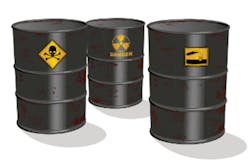EPA Issues Updates for April 2012 Oil and Natural Gas Standards for Storage Tanks
The U.S. Environmental Protection Agency (EPA) issued updates to its April 2012 oil and natural gas standards for storage tanks, which allow responsible oil and natural gas production while ensuring air emissions are reduced as quickly as possible. The updates will phase in emission control deadlines, starting with higher-emitting tanks first, and will provide the time needed to ramp up the production and installation of controls. EPA is making the changes based on information received after the 2012 standards were issued that shows more storage tanks will come online than the agency originally estimated, according to a press release from the EPA.
Storage tanks that emit 6 or more tons of volatile organic compounds (VOCs) a year must reduce emissions by 95 percent. This rule establishes two emission control deadlines:
• Tanks that come online after April 12, 2013 are likely to have higher emissions and must control VOC emissions within 60 days or by April 15, 2014, whichever is later; and
• Tanks that came online before April 12, 2013 are likely to have lower emissions and must control VOC emissions by April 15, 2015.
The updated standards also establish an alternative emissions limit that would allow owners/operators to remove controls from tanks if they can demonstrate that the tanks emit less than 4 tons per year of VOC emissions without controls. In addition, the rule streamlines compliance and monitoring requirements for tanks that have already installed controls.
The oil and natural gas industry uses tanks for temporary storage of crude oil, condensate and other liquids, before those liquids are moved to a pipeline, sold or moved for disposal. These storage tanks can be sources of emissions of ozone-forming VOCs, along with several toxic air pollutants, including benzene. This final action does not affect the April 2012 standards for capturing natural gas from hydraulically fractured wells.
These updates respond to petitions for reconsideration of the 2012 New Source Performance Standards for Oil and Natural Gas Production. Those cost-effective standards rely on proven technologies and best practices to reduce emissions of ozone-forming VOCs and air toxics, including benzene and hexane. Exposure to ozone is linked a variety of health effects, including aggravated asthma, reduced lung function and increased susceptibility to respiratory infections, in addition to increased risk of premature death from heart or lung disease. Benzene and hexane are air toxics, which can cause cancer and other serious health effects.



